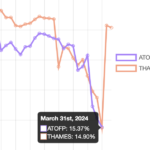I first encountered the Higgs boson in 1989 on a blackboard in an advanced quantum field theory class for graduate students at Harvard University. It was the point that I realized that the life of a theoretical physicist was not for me.
I remember the lecture theatre well. There were three blackboards side by side, and each one consisted of a continuous belt which the lecturer could pull down to expose extra space to write on. The system allowed long mathematical arguments to be written down without the need to erase them in mid-flow. As it happened, the mathematics needed to describe the Higgs boson ““ the electroweak theory ““ pushed that system to its limit.
In quantum field theory, you start out with something called a Lagrangian ““ a kind of balance sheet for the stuff of nature. I’ve been writing about finance for so long now that whereas I once used physics analogies to describe finance, I now use finance analogies to describe physics.
The things you think are fundamental ““ electrons, neutrinos, quarks and so on ““ are written down in this Lagrangian. There’s a lot of infrastructure built into this statement: I say ‘electron’ but you write it as a symbol for a complex-number vector that has a value at every point in space and time ““ a quantum field. If you want to stop reading here, don’t worry, I’m not going to go further into that sort of detail.
So let’s go back to the balance sheet analogy. Imagine a company producing and selling differing products around the world, say cars, light trucks, heavy goods vehicles. These are the ‘fermions’ that appear in the Lagrangian, the neutrinos, electrons and quarks. How do they interact on the balance sheet? Suppose you come up with a rule that the value of the company is independent of any change in exchange rates in the countries where the company does business. No matter what combination of local foreign exchange rate changes you apply, the company’s earnings aren’t affected.
In physics, that’s what would be called a ‘gauge’ and saying that a Lagrangian is locally gauge-invariant is quite a strong statement. To make it work, you have to fix the Lagrangian, adding new bits to balance everything out. In the corporate analogy, you might have to add currency-hedging contracts to keep the balance sheet fixed in the event of foreign exchange swings. In physics, these new bits turn out to be forces between the fermions, transmitted by so-called gauge bosons.
In the ‘simple’ form of gauge field theory, such as the quantum electrodynamics invented by Richard Feynman and others in the 1940s, gauge bosons have zero mass. In my corporate analogy, you could imagine a hedge accounting rule that kept the bosons out of the company’s income statement.
In 1989 I had learned how this theory worked, including lots of messy details about particles scattering off each other and how infinities were avoided in the calculations. Then the professor introduced electroweak theory. It was necessary because gauge theories on their own didn’t explain reality. For example, we knew that the neutrino had to be a fermion ““ so why did it have zero mass?
The answer was to combine electromagnetism and the weak nuclear force in a special way. You wrote down a long, complicated Lagrangian and combined two separate gauge symmetries within it. Then you added a separate quantum field that interacted with everything ““ the Higgs field. Something strange happened to the Higgs field though. It underwent ‘spontaneous symmetry breaking’, presumably back in the Aboriginal dreamtime of the moments just after the Big Bang.
In physics books, the symmetry breaking is often described using the example of a magnet where lots of particles all end up pointing in one direction as they cool below a certain temperature. The Higgs field does something like that, but more radical is the effect this has on the Lagrangian, which effectively rearranges itself.
Going back to the corporate analogy, it’s like a new accounting rule appears from nowhere ““ say, pension accounting ““ triggering a new balance sheet for the company. Whereas before you had cars, light trucks and heavy vehicles as your ‘fermions’ you now had cars, light trucks and pension liabilities. Â Particles that start out being massless acquire mass. In physics, that explains a good part of the world we see.
That electroweak Lagrangian covered all three blackboards in the Harvard lecture theatre. I could barely keep up: I was still in the middle of trying to comprehend and write it all down when the professor started erasing it. There was one final term in the equation I missed completely.
I spoke to the professor later in his office. He realised that I was in the lower tail of the distribution of following his class, and spoke to me frankly about the costs and benefits of theoretical physics as a career. He had just been passed over for tenure at Harvard and was slightly bitter about it. “I have given up more than half a million dollars on Wall Street by doing this job”, he said.
I didn’t anticipate that I would end up writing about Wall Street, but shortly after that encounter I began to move away from theoretical physics for good. And the last term that I missed writing down? It was interaction between the Higgs particle and the others in the theory, which made possible the discovery at the Large Hadron Collider announced last week. The Higgs particle was there on the blackboard, waving me goodbye.
Comments are closed.
 Levelling the Playing Field
Levelling the Playing Field
 Barclays and Labour's growth plan
Barclays and Labour's growth plan
 Plummeting bonds reflect souring UK mood for outsourcing and privatisation
Plummeting bonds reflect souring UK mood for outsourcing and privatisation
 Dimon rolls trading dice with excess capital
Dimon rolls trading dice with excess capital
Very amusing Nicky.
You must be the only person who would dare attempt to explain such high level physics by making parellels with the world of finance.
Nick, not sure i quite followed up the bit
“Going back to the corporate analogy, it’s like a new accounting rule appears from nowhere ““ say, pension accounting ““ triggering a new balance sheet for the company. Whereas before you had cars, light trucks and heavy vehicles as your ‘fermions’ you now had cars, light trucks and pension liabilities. Particles that start out being massless acquire mass. In physics, that explains a good part of the world we see.”
what is the mass in this analogy?